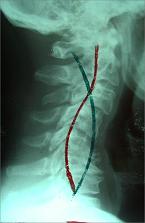As we watch our parents and grandparents age poorly and move into nursing homes, we want something better for ourselves in old age. We want to age well. Which 50-year-old would you choose to be?
Healthy neck X-ray of a 50-year-old (the person is facing to the right): no evidence of osteoarthritis or degenerative disc disease, and no interference to the function of the brainstem or spinal cord.

Diseased neck X-ray of a 50-year-old: advanced osteoarthritis (bone spurs) and advanced degenerative disc disease, with pressure on the brainstem causing malfunction of body systems.
If people wore their spines on their faces, everyone would be taking good care of their spine and nervous system, guaranteed! It is not our intent to frighten people, but to help them understand that they have choices in their quality of life as they age. The choices you make today will affect your life 10, 20, and even 30 years from now. The same is true regarding the choices you make for your children. Make a positive choice by adding a chiropractor to your health care team!
Aging is a requirement. Deterioration is optional.
About the author: Dr. Barbara Kaiser, DC, CCWP, is a wellness-certified family chiropractor at Vital Life Chiropractic in Eagan, Minnesota.

